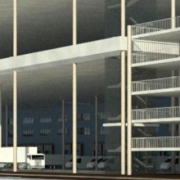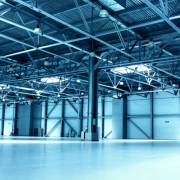Cold Storage And E-Commerce, But Not Amazon, Sustaining South Florida’s Industrial Boom
For most of the last few years, Amazon has been the dominant force in South Florida’s industrial market, but the e-commerce giant’s recent pullback hasn’t had a negative impact on the region’s warehouse market, industry insiders said at Bisnow‘s South Florida Industrial Outlook event last week.
“The last few years it has all been Amazon, right? They were making 90% of that e-commerce growth. They were really bailing us out of all that space we could not lease,” Bridge Industrial Vice President Aaron Hirschl said at the event. “Now it’s everybody else playing catch-up. It is 85% of all the e-commerce deals are other groups other than Amazon. It’s really good to see that positive growth there.”
The vacancy rate for South Florida industrial properties dropped to 1.8% in the third quarter, according to JLL research. Rents have grown 60% year-over-year, to an all-time record of $14.35 per SF. Construction is speeding up as a result: So far in 2022, approximately 2.3M SF of new product has been delivered. Over the next 18 months, JLL projects deliveries to hit 7.8M SF.
“Much of that is still fueled by e-commerce, even in the absence of the industry’s leader,” Prologis Vice President Jason Tenenbaum said at the event, held at the GalleryOne Fort Lauderdale by Hilton. “I’d say e-commerce continues to be the predominant player, I am guessing in the majority of our portfolios, and that’s notable particularly because of Amazon’s specific slowdown this year,” he said. “I would say the vast majority of our work is centered around that space.”
Tenenbaum said that he expects more leasing in the e-commerce space to come from third-party logistics companies as retailers themselves look to outsource their distribution. Those companies, called 3PLs, have accounted for more than 35% of all warehouse leasing in South Florida so far this year, according to a just published CBRE report.
“I think as pricing and rents continue to rise and supply is constrained, you will see a lot more of all of our clients electing to 3PL their supply chain,” Tenenbaum said.
After e-commerce, the biggest driver of demand in the industrial market is in the food and beverage industry and their need for cold storage, developers at the event said. The global cold storage market was over $9.6B last year and is projected to reach $11.3B this year and hit $25.4B by 2027, according to an October market report by Reportlinker.
“If you look at where the demand is the most nationally, clearly cold storage will be it,” BBX Logistics Properties Mark Levy said. “In South Florida, if you look at the footprint of the market as a percentage of the total base, it’s a very, very small amount of cold storage space product that has been delivered.”
Tenenbaum said that the tourism industry in particular has been active in looking for cold storage properties, a piece of the market that had been largely absent for the previous two to three years.
“There was a time in the last 24 to 36 months where the tourism activity was way down. Now it’s back at a high pre-pandemic levels,” Tenenbaum said. “As tourism has come back and the cruise ships are set to sail again, that’s a really active space.”
Levy said that while the cold storage market is “still tremendously undersupplied,” building the space on a speculative basis is still a rarity. But Bridge Industrial launched a spec cold storage warehouse in Hialeah last year, and signed FreezePak to a 312K SF lease in March.
“I remember when Bridge was working on that development and we thought ‘Those guys are crazy! There is no way that they are going to get those rents,’” Hirschl said. “And sure enough, they leased it out and knocked it out of the park. They proved a thesis and it was really cool to see it happen.”
Kroger, the largest grocery chain in the country, doesn’t have a supermarket in South Florida, but it opened a 60K SF warehouse in Opa-Locka this year to start delivering groceries directly to customers’ homes. Kroger said in its September earnings report that its delivery sales grew by 34% from the previous year.
“Kroger does not have any grocery stores here but they are renting near people’s homes,” Hirschl said. “That trend is really interesting to see if they can really penetrate the market here.”
Butters Construction & Development Director of Acquisitions Adam Vaisman said on a panel that, in addition to e-commerce and food and beverage companies, manufacturing is an increasing presence in the market. He said his firm signed a 200K SF lease with a manufacturing firm in Broward County and was getting ready to break ground.
“You will definitely see more of the manufacturing jobs, especially given our labor pool here in South Florida,” Vaisman said. “We are definitely starting to see that and I think that trend is starting to pick up if you continue to have global instability the way we do.”
But while manufacturers and cold storage providers largely need specialized space, e-commerce users are taking any space they can get in a market with soaring rents and sub-2% vacancy.
“Location is the most important always, so for e-commerce users, if they can’t find a new building and it’s a market they need to be in, they will make it work with a Class-B space or a Class-C space,” said Seagis Property Group Vice President of Florida Acquisitions and Leasing Bradlee Lord. “Public transportation will only get increasingly worse as the population grows. With Covid in 2020, the roads were still relatively busy. Location matters as congestion gets worse.”
Source: Bisnow











